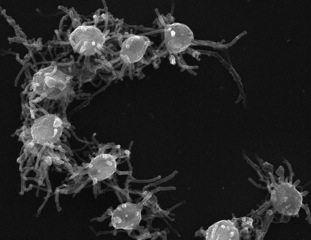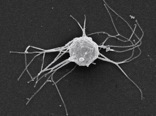
Nucleariida is a group of amoebae with filose pseudopods, known mostly from soils and freshwater. They are distinguished from the superficially similar vampyrellids mainly by having mitochondria with discoid cristae, in the absence of superficial granules, and in the way they consume food.

The opisthokonts are a broad group of eukaryotes, including both the animal and fungus kingdoms. The opisthokonts, previously called the "Fungi/Metazoa group", are generally recognized as a clade. Opisthokonts together with Apusomonadida and Breviata comprise the larger clade Obazoa.

Lobosa is a taxonomic group of amoebae in the phylum Amoebozoa. Most lobosans possess broad, bluntly rounded pseudopods, although one genus in the group, the recently discovered Sapocribrum, has slender and threadlike (filose) pseudopodia. In current classification schemes, Lobosa is a subphylum, composed mainly of amoebae that have lobose pseudopods but lack cilia or flagella.

Amorphea is a taxonomic supergroup that includes the basal Amoebozoa and Obazoa. That latter contains the Opisthokonta, which includes the Fungi, Animals and the Choanomonada, or Choanoflagellates. The taxonomic affinities of the members of this clade were originally described and proposed by Thomas Cavalier-Smith in 2002.

Cristidiscoidea or Nucleariae is a proposed basal holomycota clade in which Fonticula and Nucleariida emerged, as sister of the fungi. Since it is close to the divergence between the main lineages of fungi and animals, the study of Cristidiscoidea can provide crucial information on the divergent lifestyles of these groups and the evolution of opisthokonts and slime mold multicellularity. The holomycota tree is following Tedersoo et al.

The Apusozoa are a paraphyletic phylum of flagellate eukaryotes. They are usually around 5–20 μm in size, and occur in soils and aquatic habitats, where they feed on bacteria. They are grouped together based on the presence of an organic shell or theca under the dorsal surface of the cell.

Nuclearia is a nucleariid genus.

Capsaspora is a monotypic genus containing the single species Capsaspora owczarzaki. C. owczarzaki is a single-celled eukaryote that occupies a key phylogenetic position in our understanding of the origin of animal multicellularity, as one of the closest unicellular relatives to animals. It is, together with Ministeria vibrans, a member of the Filasterea clade. This amoeboid protist has been pivotal to unravel the nature of the unicellular ancestor of animals, which has been proved to be much more complex than previously thought.

Ministeria vibrans is a bacterivorous amoeba with filopodia that was originally described to be suspended by a flagellum-like stalk attached to the substrate. Molecular and experimental work later on demonstrated the stalk is indeed a flagellar apparatus.

Breviata anathema is a single-celled flagellate amoeboid eukaryote, previously studied under the name Mastigamoeba invertens. The cell lacks mitochondria, much like the pelobionts to which the species was previously assigned, but has remnant mitochondrial genes, and possesses an organelle believed to be a modified anaerobic mitochondrion, similar to the mitosomes and hydrogenosomes found in other eukaryotes that live in low-oxygen environments.

Testate amoebae are a polyphyletic group of unicellular amoeboid protists, which differ from naked amoebae in the presence of a test that partially encloses the cell, with an aperture from which the pseudopodia emerge, that provides the amoeba with shelter from predators and environmental conditions.

Filasterea is a proposed basal Filozoan clade of single-celled ameboid eukaryotes that includes Ministeria and Capsaspora. It is a sister clade to the Choanozoa in which the Choanoflagellatea and Animals appeared, originally proposed by Shalchian-Tabrizi et al. in 2008, based on a phylogenomic analysis with dozens of genes. Filasterea was found to be the sister-group to the clade composed of Metazoa and Choanoflagellata within the Opisthokonta, a finding that has been further corroborated with additional, more taxon-rich, phylogenetic analyses.

Holozoa is a clade of organisms that includes animals and their closest single-celled relatives, but excludes fungi and all other organisms. Together they amount to more than 1.5 million species of purely heterotrophic organisms, including around 300 unicellular species. It consists of various subgroups, namely Metazoa and the protists Choanoflagellata, Filasterea, Pluriformea and Ichthyosporea. Along with fungi and some other groups, Holozoa is part of the Opisthokonta, a supergroup of eukaryotes. Choanofila was previously used as the name for a group similar in composition to Holozoa, but its usage is discouraged now because it excludes animals and is therefore paraphyletic.

Trichosphaerium is a genus of amoebozoan protists that present extraordinary morphological transformations, both in size and shape, during their life cycle. They can present a test that may or may not be covered in spicules. They are related to the family Microcoryciidae, which contains other amoebae with tests, within the clade Corycidia of the phylum Amoebozoa.

The apusomonads are a group of protozoan zooflagellates that glide on surfaces, and mostly consume prokaryotes. They are of particular evolutionary interest because they appear to be the sister group to the Opisthokonts, the clade that includes both animals and fungi. Together with the Breviatea, these form the Obazoa clade.

Holomycota or Nucletmycea are a basal Opisthokont clade as sister of the Holozoa. It consists of the Cristidiscoidea and the kingdom Fungi. The position of nucleariids, unicellular free-living phagotrophic amoebae, as the earliest lineage of Holomycota suggests that animals and fungi independently acquired complex multicellularity from a common unicellular ancestor and that the osmotrophic lifestyle was originated later in the divergence of this eukaryotic lineage. Opisthosporidians is a recently proposed taxonomic group that includes aphelids, Microsporidia and Cryptomycota, three groups of endoparasites.

Opisthosporidia is a superphylum of intracellular parasites with amoeboid vegetative stage, defined as a common group of eukaryotic groups Microsporidia, Cryptomycota and Aphelidea. They have been considered to represent a monophyletic lineage with shared ecological and structural features, being a sister clade of the Fungi. Together with the Fungi they represent a sister clade of the Cristidiscoidea, together forming the Holomycota.

Creolimax fragrantissima is a single-celled protist that occupies a key phylogenetic position to understand the origin of animals. It was isolated from the digestive tract of some marine invertebrates, mainly from the peanut worm, collected from the Northeast Pacific.
The Scotokaryotes (Cavalier-Smith) is a proposed basal Neokaryote clade as sister of the Diaphoretickes. Basal Scotokaryote groupings are the Metamonads, the Malawimonas and the Podiata. In this phylogeny the Discoba are sometimes seen as paraphyletic and basal Eukaryotes.

An amoeboflagellate is any eukaryotic organism capable of behaving as an amoeba and as a flagellate at some point during their life cycle. Amoeboflagellates present both pseudopodia and at least one flagellum, often simultaneously.















